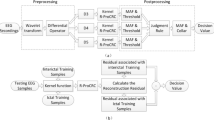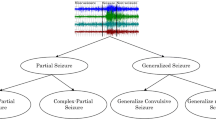Abstract
Detection of interictal epileptic discharges (IED) events in the EEG recordings is a critical indicator for detecting and diagnosing epileptic seizures. We propose a key technology to extract the most important features related to epileptic seizures and identifies the IED events based on the interaction between frequencies of EEG with the help of a two-level recurrent neural network. The proposed classification network is trained and validated using the largest publicly available EEG dataset from Temple University Hospital. Experimental results clarified that the interaction between β and β bands, β and γ bands, γ and γ bands, δ and δ bands, θ and α bands, and θ and β bands have a significant effect on detecting the IED discharges. Moreover, the obtained results showed that the proposed technique detects 95.36% of the IED epileptic events with a false-alarm rate of 4.52% and a precision of 87.33% by using only 25 significant features. Furthermore, the proposed system requires only 164 ms for detecting a 1-s IED event which makes it suitable for real-time applications
Similar content being viewed by others
References
de Cooman T, Varon C, van de Vel A, et al. Adaptive nocturnal seizure detection using heart rate and low-complexity novelty detection. Seizure, 2018, 59: 48–53
World Health Organization. Epilepsy in the Western Pacific Region: A Call to Action: Global Campaign Against Epilepsy. Manila: WHO Regional Office for the Western Pacific, 2004
Zacharaki E I, Mporas I, Garganis K, et al. Spike pattern recognition by supervised classification in low dimensional embedding space. Brain Inf, 2016, 3: 73–83
Wang S K, Pang B, Liu M, et al. A novel compression framework using energy-sensitive QRS complex detection method for a mobile ECG. Sci China Inf Sci, 2019, 62: 069409
Zhang Q R, Xie Q S, Duan K F, et al. A digital signal processor (DSP)-based system for embedded continuous-time cuffless blood pressure monitoring using single-channel PPG signal. Sci China Inf Sci, 2020, 63: 149402
Xu C Q, Liu Y, Yang Y T. An intelligent partitioning approach of the system-on-chip for flexible and stretchable systems. Sci China Inf Sci, 2018, 61: 060415
Bai B W, Shu H W, Wang X J, et al. Towards silicon photonic neural networks for artificial intelligence. Sci China Inf Sci, 2020, 63: 160403
Golmohammadi M, Harati A, de Diego S L, et al. Automatic analysis of EEGs using big data and hybrid deep learning architectures. Front Hum Neurosci, 2019, 13: 1–14
Carey H J, Manic M, Arsenovic P. Epileptic spike detection with EEG using artificial neural networks. In: Proceedings of International Conference on Human System Interactions (HSI), 2016. 89–95
Lodder S S, Askamp J, van Putten M J A M. Inter-ictal spike detection using a database of smart templates. Clin Neurophysiol, 2013, 124: 2328–2335
Malik M H, Saeed M, Kamboh A M. Automatic threshold optimization in nonlinear energy operator based spike detection. In: Proceedings of International Conference of IEEE Engineering in Medicine and Biology Society (EMBC), 2016. 774–777
Tieng Q M, Kharatishvili I, Chen M, et al. Mouse EEG spike detection based on the adapted continuous wavelet transform. J Neural Eng, 2016, 13: 026018
Liu Y C, Lin C C, Tsai J J, et al. Model-based spike detection of epileptic EEG data. Sensors, 2013, 13: 12536–12547
Douget J E L, Fouad A, Filali M M, et al. Surface and intracranial EEG spike detection based on discrete wavelet decomposition and random forest classification. In: Proceedings of International Conference of IEEE Engineering in Medicine and Biology Society (EMBC), 2017. 475–478
Quintero-Rincón A, Muro V, D’Giano C. Spike-and-wave detection in epileptic signals using cross-correlation and decision trees. Rev Argent de Bioingeniería, 2018, 22: 3–6
Assi E B, Gagliano L, Rihana S, et al. Bispectrum features and multilayer perceptron classifier to enhance seizure prediction. Sci Rep, 2018, 8: 15491
Chua C K, Chandran V, Acharya R, et al. Higher order spectral (HOS) analysis of epileptic EEG signals. In: Proceedings of International Conference of IEEE Engineering in Medicine and Biology Society, 2007. 6495–6498
Al-Kadi M, Reaz M, Ali M. Evolution of electroencephalogram signal analysis techniques during anesthesia. Sensors, 2013, 13: 6605–6635
Kumar D, Jadeja R, Pande S, et al. Wavelet bispectrum-based nonlinear features for cardiac murmur identification. Cogent Eng, 2018, 5: 1502906
Elsayed M A K. Wavelet bicoherence analysis of wind-wave interaction. Ocean Eng, 2006, 33: 458–470
Hadjileontiadis L J. EEG-based tonic cold pain characterization using wavelet higher order spectral features. IEEE Trans Biomed Eng, 2015, 62: 1981–1991
Obeid I, Picone J. The temple university hospital EEG data corpus. Front Neurosci, 2016, 10: 196
Lopez S, Gross A, Yang S, et al. An analysis of two common reference points for EEGS. In: Proceedings of IEEE Signal Processing in Medicine and Biology Symposium (SPMB), 2016. 1–5
Esteller R, Vachtsevanos G, Echauz J, et al. A comparison of waveform fractal dimension algorithms. IEEE Trans Circ Syst I, 2001, 48: 177–183
Richman J S, Moorman J R. Physiological time-series analysis using approximate entropy and sample entropy. Am J Physiol-Heart Circ Physiol, 2000, 278: 2039–2049
Akansu A N, Haddad R A. Multiresolution Signal Decomposition. 2nd ed. San Diego: Academic Press, 2001
Bentley P M, McDonnell J T E. Wavelet transforms: an introduction. Electron Commun Eng J, 1994, 6: 175–186
Hou C, Han H, Liu Z J, et al. A wind direction forecasting method based on z-score normalization and long short-term memory. In: Proceedings of the 3rd International Conference on Green Energy and Applications (ICGEA), 2019. 172–176
Huang D Q, Fu Y Z, Qin N, et al. Fault diagnosis of high-speed train bogie based on LSTM neural network. Sci China Inf Sci, 2021, 64: 119203
Zaremba W, Sutskever I, Vinyals O. Recurrent neural network regularization. 2014. ArXiv:1409.2329
Bai X, Pang Y W, Zhang G F. Special focus on deep learning for computer vision. Sci China Inf Sci, 2019, 62: 220100
Estabrooks A, Jo T, Japkowicz N. A multiple resampling method for learning from imbalanced data sets. Comput Intell, 2004, 20: 18–36
Peng H C, Long F H, Ding C. Feature selection based on mutual information: criteria of max-dependency, max-relevance, and min-redundancy. IEEE Trans Pattern Anal Mach Intell, 2005, 27: 1226–1238
Wang S, Yao X. Multiclass imbalance problems: analysis and potential solutions. IEEE Trans Syst Man Cybern B, 2012, 42: 1119–1130
Reus E E M, Visser G H, Cox F M E. Determining the spike-wave index using automated detection software. J Clin Neuro-Physiol, 2019. doi: https://doi.org/10.1097/WNP.0000000000000672
Zarifia M H, Ghalehjogh N K, Baradaran-nia M. A new evolutionary approach for neural spike detection based on genetic algorithm. Expert Syst Appl, 2015, 42: 462–467
Pfammatter J A, Maganti R K, Jones M V. An automated, machine learning-based detection algorithm for spike-wave discharges (SWDs) in a mouse model of absence epilepsy. Epilepsia Open, 2019, 11: 110–122
Acknowledgements
This work was supported in part by National Key Research and Development Program of China (Grant No. 2019YFB2204500), National Natural Science Foundation of China (Grant No. 61874171), and Alibaba Group through Alibaba Innovative Research (AIR) Program.
Author information
Authors and Affiliations
Corresponding authors
Rights and permissions
About this article
Cite this article
Sabor, N., Li, Y., Zhang, Z. et al. Detection of the interictal epileptic discharges based on wavelet bispectrum interaction and recurrent neural network. Sci. China Inf. Sci. 64, 162403 (2021). https://doi.org/10.1007/s11432-020-3100-8
Received:
Revised:
Accepted:
Published:
DOI: https://doi.org/10.1007/s11432-020-3100-8




